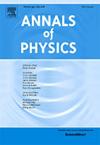Hawking temperature and the inverse-radius scale of the horizon
IF 3
3区 物理与天体物理
Q2 PHYSICS, MULTIDISCIPLINARY
引用次数: 0
Abstract
The Hawking temperature of a Schwarzschild black hole can be heuristically derived by identifying the temperature with the inverse radius of the horizon up to a multiplicative constant. This does not work for more general black holes such as the Kerr and Reissner–Nordström solutions. Expounding on the details of how it fails to work nevertheless uncovers some connections with the “spring constant” of black holes and with black hole thermodynamics.
求助全文
约1分钟内获得全文
求助全文
来源期刊

Annals of Physics
物理-物理:综合
CiteScore
5.30
自引率
3.30%
发文量
211
审稿时长
47 days
期刊介绍:
Annals of Physics presents original work in all areas of basic theoretic physics research. Ideas are developed and fully explored, and thorough treatment is given to first principles and ultimate applications. Annals of Physics emphasizes clarity and intelligibility in the articles it publishes, thus making them as accessible as possible. Readers familiar with recent developments in the field are provided with sufficient detail and background to follow the arguments and understand their significance.
The Editors of the journal cover all fields of theoretical physics. Articles published in the journal are typically longer than 20 pages.
 求助内容:
求助内容: 应助结果提醒方式:
应助结果提醒方式:


